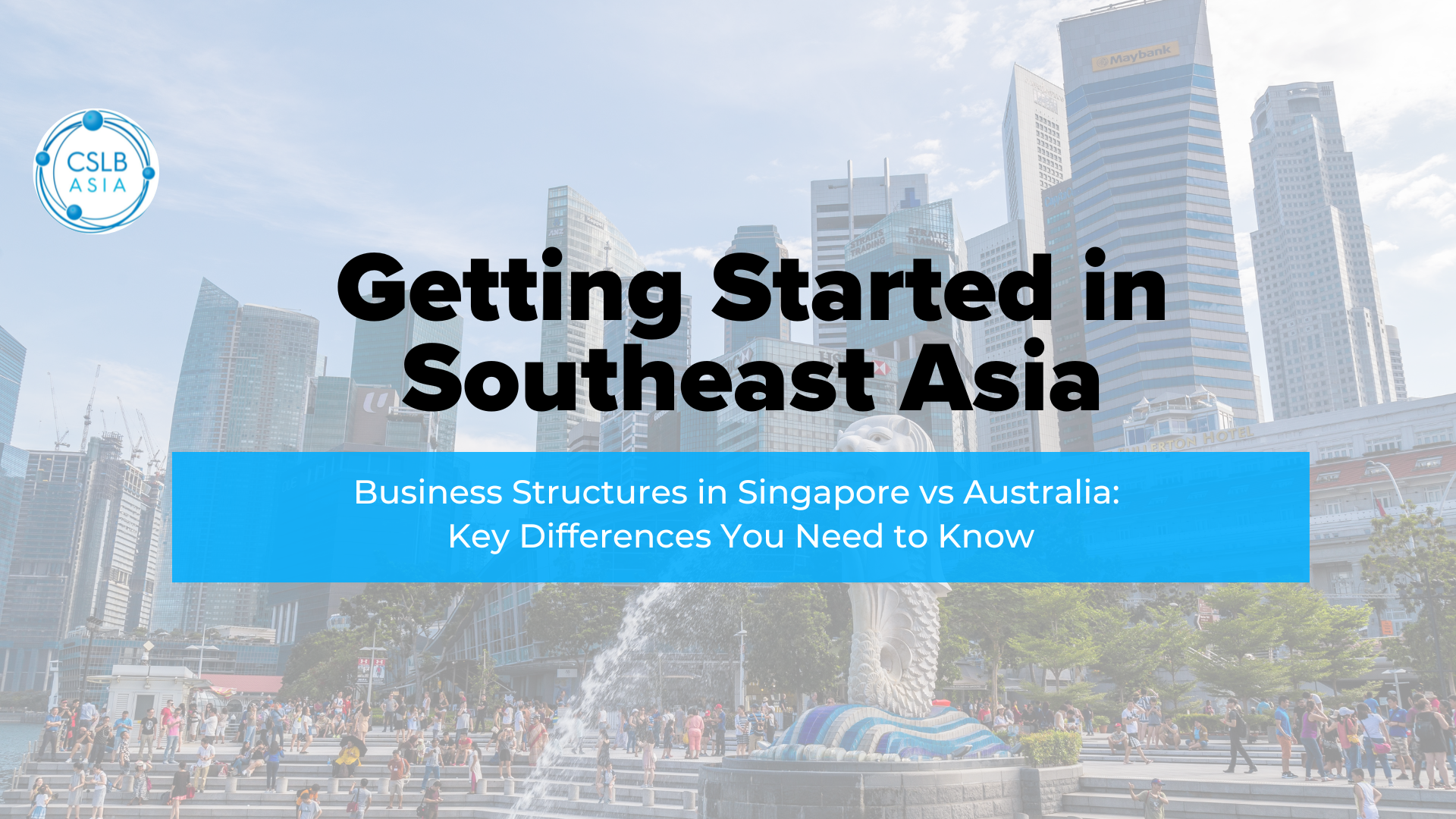Getting Started in Southeast Asia
Business Structures in Singapore vs Australia: Key Differences You Need to Know
Published July, 2025
You've spent months perfecting your business model, built a solid customer base in Australia, and now you're ready to take the leap into Southeast Asia. Singapore seems like the perfect gateway – English-speaking, business-friendly, and strategically located. You figure you'll just replicate your Australian Pty Ltd structure and be up and running in no time.
Six months later, you're drowning in unexpected compliance requirements, facing double taxation issues you never saw coming, and wondering why your "simple" business setup has turned into a bureaucratic nightmare.
Sound like a cautionary tale? Unfortunately, it's one I see play out repeatedly with Australian entrepreneurs who underestimate the critical importance of choosing the right business structure for their Singapore expansion.
Having guided Australian businesses through successful Southeast Asian expansions, I can't stress enough how crucial it is to understand the fundamental differences between Australian and Singaporean business structures before you make your move. In this article, I'm diving deep into these key differences, but if you'd like personalised guidance on which structure best suits your specific business needs, I also offer a one-on-one Power Hour to help you navigate these crucial decisions from day one.
The Foundation: Why Structure Matters More Than You Think
While Australia and Singapore may both operate under common law systems, their business structure frameworks couldn't be more different in practice. What works brilliantly for tax efficiency and liability protection in Melbourne might create unnecessary complications in Singapore.
In Australia, we're accustomed to the world of sole traders, partnerships, companies, and trusts. Singapore's business landscape offers similar options but with vastly different regulatory requirements, tax implications, and operational complexities.
The biggest mistake I see Australian entrepreneurs make is assuming that because Singapore is "business-friendly," the setup process will be simpler. In reality, while Singapore excels at efficiency once you understand the system, choosing the wrong structure upfront can cost you in both delays and unnecessary fees.
Private Limited Companies: Same Name, Different Game
Most Australian businesses operate as Pty Ltd companies, and naturally assume a Singapore Private Limited Company (Pte Ltd) will function similarly. While both offer limited liability protection, the similarities end there.
In Singapore, every Pte Ltd company must have at least one director who is either a Singapore citizen, permanent resident, or holds an Employment Pass (with the approval of their employer and the Ministry of Manpower). This residency requirement catches many Australian entrepreneurs off guard, forcing them to either relocate a director, hire a local nominee director, or restructure their entire expansion plans.
Perhaps most importantly, Singapore's compliance requirements are far more stringent. Annual General Meetings are mandatory (unless waiver by resolution, the appointment of a company secretary, financial statements must be filed annually regardless of activity level, and the penalties for late filing are both swift and substantial.
Tax Implications: The Hidden Iceberg
Here's where many Australian businesses get blindsided. Singapore's headline corporate tax rate of 17% looks attractive compared to Australia's 25-30%, but the devil is in the details.
Singapore operates a territorial tax system, meaning you only pay tax on income earned in Singapore. This sounds appealing until you realise that determining what constitutes "Singapore-sourced income" for a business serving regional markets can be incredibly complex.
The interaction between Australian and Singapore tax systems can create unexpected double taxation scenarios. Without proper structure planning, you might find yourself paying tax in both countries on the same income, completely eroding the tax benefits you expected from your Singapore expansion.
Branch Office vs Subsidiary: The Critical Choice
Australian businesses often default to setting up a subsidiary (Pte Ltd) without considering whether a branch office might be more suitable.
A branch office is simpler to establish and maintain, with less compliance burden. However, it offers no liability protection – the Australian parent company remains fully liable for all Singapore operations. For service-based businesses with lower risk profiles, this can be an elegant solution.
A subsidiary provides liability protection but requires full compliance with Singapore's corporate requirements. It's a separate legal entity, which means additional complexity but also additional protection.
The tax implications differ dramatically too. Branch profits are generally subject to branch profits tax, while subsidiary distributions may qualify for dividend exemptions under certain conditions.
The Compliance Minefield: What Keeps Me Up at Night
Beyond structure selection, ongoing compliance requirements represent the biggest operational difference between Australian and Singapore business operations.
Annual filing deadlines are non-negotiable. Miss your deadline in Australia, and you might face penalties. Miss it in Singapore, and you're looking at director penalties, potential criminal liability, and the very real possibility of involuntary company strike-off.
The good news? Once you understand the system, Singapore's compliance requirements are actually more predictable than Australia's constantly changing regulations.
QUICK TIP: First Steps Checklist Before Making Your Expansion Move
Before you commit to any business structure in Singapore, ensure you've completed this essential groundwork:
Business Model Analysis:
✓ Map exactly where your revenue will be generated geographically
✓ Identify which activities will be performed in Singapore vs Australia
✓ Determine your liability exposure for Singapore operations
✓ Assess your need for local directors and shareholders
Tax Planning Foundation:
✓ Engage both Australian and Singapore tax advisors before structure selection, or someone who can advise on both
✓ Model tax implications under different structure scenarios
✓ Understand transfer pricing implications if moving IP or services between entities
✓ Review existing Australian tax elections that might impact Singapore operations
Regulatory Requirements:
✓ Research industry-specific licensing requirements in Singapore
✓ Understand ongoing compliance obligations for your chosen structure
✓ Identify any foreign investment restrictions in your sector
✓ Confirm employment pass eligibility for key personnel
Banking and Finance:
✓ Research banking requirements for different business structures
✓ Understand Singapore's requirements for foreign exchange and fund transfers
✓ Plan your initial capitalisation strategy
✓ Consider how you'll handle inter-company transactions
Critical DON'Ts:
✗ Don't assume Australian compliance timelines apply in Singapore
✗ Don't choose a structure based solely on tax rates
✗ Don't proceed without understanding director residency requirements
The Bottom Line
Singapore offers unparalleled opportunities for Australian businesses looking to access Southeast Asian markets, but success depends heavily on making informed structure decisions from day one. The entrepreneurs I see thrive aren't necessarily those with the most capital or the flashiest business models – they're the ones who invest time upfront to understand Singapore's regulatory landscape and choose structures that support their long-term growth strategy.
The structural differences between Australian and Singapore business entities aren't just administrative details – they're strategic decisions that will impact every aspect of your operations, from tax efficiency to operational flexibility to exit planning.
Most importantly, while Singapore's business environment is incredibly sophisticated, it rewards preparation, so take the time to understand these differences, engage qualified advisors early, and structure your expansion for sustainable success.
Remember, in Singapore expansion, the structure you choose today determines the opportunities available to you tomorrow. Get it right from the start, and you'll have a platform for regional growth that can scale with your ambitions.
As the CEO of CSLB-Asia, I can support your business by drawing on years of hands-on experience helping Australian companies navigate Singapore's business structures and regulatory requirements. Based between Singapore and Australia, I specialise in helping Australian businesses make informed structure decisions that support their Southeast Asian expansion goals.
I look forward to supporting your business success in Southeast Asia.
Regards
Katherine Chapman
📧 katherine@cslb-asia.com
📱 +65 819 86 880 | +61 434 174 941
Stay Connected: Website | Facebook | Instagram | Pinterest
BOOK A POWER HOUR WITH ME
Ready to navigate the cultural complexities of Southeast Asian expansion?
You can book a Power Hour consultation with me to discuss the finer details of what a transition to Southeast Asia would look like for you, your business, and your family. From relocating a family to Singapore (based on real experience of someone who has successfully made this move!) to understanding leasing requirements for both personal and commercial properties, and making the right connections - get the insider knowledge that can make or break your Southeast Asian venture.
Click here to book your Power Hour and turn cultural awareness into competitive advantage.
Disclaimer: This article reflects personal interpretations and opinions as a thought leader in compliance in Asia.

